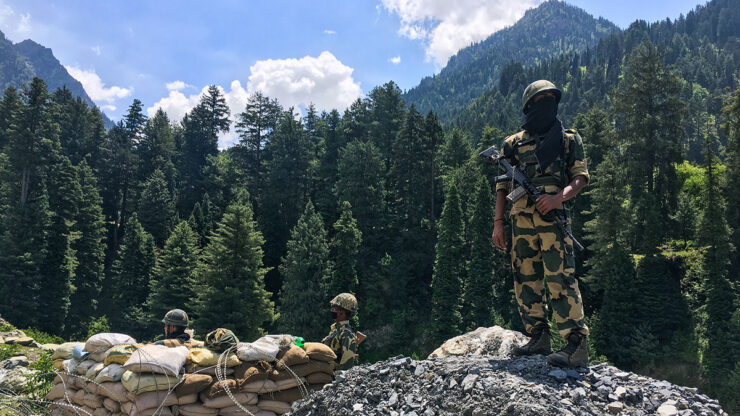
China’s recent enactment and adoption of the Land border Law is an endeavor to strengthen its border control and protection mechanism albeit with a tacit undertone of digging its heels on its perception of the border alignment in disputed areas.
Like the coastguard and maritime law, the Standing Committee of the National People’s Congress, the top legislative body passed the new land law on Oct 23, for the “protection and exploitation of the country’ island border areas” which has come into effect from 1 January 2022.
China’s land border Law
The law per se states that “the sovereignty and territorial integrity of…China are sacred and inviolable”, and that the state shall “take all possible measures to safeguard territorial integrity and land boundaries including combating any act that undermines it”.
It authorises the state to take such measures in border areas so as “to strengthen border defence, support economic and social development as well as improve public services and infrastructure in such areas, encourage and support people’s life and work there, and promote coordination between border defence and socioeconomic development”.
There is thus a tacit implication of integrating civilian in the border management by way of managing civilian settlements in the border areas with the dual aim of laying claims to dispute areas as Chinese territory as well as develop and employ border infrastructure as a ruse for military use.
However, interestingly, the law also asks the state to follow the principles of “equality, mutual trust, and friendly consultation, handle land border related-affairs with neighbouring countries through negotiations to mutually resolve disputes and longstanding border issues”.
Internally, the law is set to streamline the existing division of land management responsibilities among various bureaucracies to include the foreign ministry, the public security ministry, and the customs and immigration administrations, and specifically places border management responsibility squarely under the People’s Liberation Army (PLA) and People’s Armed Police (PAP).
The law specifies that the Central Military Commission, will be responsible for safeguarding the land border, resisting armed invasion, and responding to major contingencies through the People’s Liberation Army (PLA) and People’s Armed Police (PAP), both under its command.
It authorises patrol officers to use police instruments and weapons against intruders who resort to intrusion, violence in resisting detention and threaten the safety of life and property of people in border areas. It also authorizes the bureaucracies to collaborate with neighbouring countries in combating the “three evils” of terrorism, separatism, and religious extremism.
China’s Mass Defence Groups
The law also notably emphasises the role of Chinese citizens and civilian institutions in supporting the PLA and PAP—a likely manifestation of the “civil-military fusion strategy” in land border management leading to border defence.
It requires local governments in border areas to allocate resources to build and strengthen “mass defence groups” with a view to support border defence missions. The concept of “mass defence” for borders, implores local residents to assist with missions to include information collection, maintenance of law and order with the sole aim of sovereignty and territorial defence.
The law clearly outlines four conditions that can prompt border shutdown, port closure, or other “emergency measures”:
@when a war or armed conflict breaks out on the periphery and threatens China’s border security and stability;
@when a major incident poses a grave threat to national security or the life and property of residents in the border area;
@when the border area is threatened as a result of a natural disaster, public health incident, or nuclear, biological, or chemical pollution;
@other situations that seriously impact the land border and security and stability in border areas.
The law also reiterates the state’s commitment to opening up these areas to the outside world and improving local public service and infrastructure, aimed at striking a balance between border defence and socio-economic development.
The law also pledges state support for constructing border towns with improved functions and capacity and cross-border cooperation zones to promote trade, tourism, and ecological protection.
China’s land borders
China shares its 22,457-km-long land boundary with 14 countries including India, the third longest after the borders with Mongolia and Russia. Unlike the Indian border, China’s borders with these two countries Mongolia and Russia are not disputed.

The only other country with which China has disputed land borders is Bhutan (477 km). Therefore, through the enactment of this new law, Beijing appears to be signalling a determination to resolve the border disputes on its preferred terms. The law sets an overall tone stating that China will “resolutely defend territorial sovereignty and land border security” while continuing to seek to settle disputes through negotiations.
Probable reasons for enacting the law
There are several factors that seem to have contributed to the enactment and adoption of the law.
First, this law reflects Beijing’s renewed concerns over the security of its land border consequent to the recent flare-up with India and Bhutan. While China has settled most of its land border disputes with 12 of its 14 neighbours, the recent confrontations on the Sino-Indian borders has prompted China to invoke measures that allows stern military action in safeguarding its continental domains with India.
Second, the COVID-19 pandemic may have triggered the need for stricter border control against a growing risk of cross-border transmission in frontier areas. The latest wave of breakouts in border towns of Yunnan, Xinjiang, and Inner Mongolia only reinforce that assessment.
Third, this law reflects Beijing’s growing concerns about the stability of its hinterland bordering Central Asia against cross border terrorism. This fear stems from the fact that the withdrawal of US forces and Taliban takeover of Afghanistan has plunged the latter in protracted turmoil and humanitarian disasters which may become a hotbed for terrorism and extremism that could quickly spread to Xinjiang.
Fourth, domestic politics may also be at play. The law enshrines President Xi Jinping’s concern for improvement of ethnic minority, thereby forging a consciousness of common identity of the Chinese nation through propaganda and indoctrination.
Although it is criticized by some observers as a euphemism for coercive ethnic assimilation, this policy was proposed by President Xi Jinping at the 2014 central conference on Xinjiang, endorsed in his 19th Party Congress report in 2017, and reiterated at central conferences on Tibet and Xinjiang in 2020.
It is noteworthy that the concept of Chinese citizens’ “homeland security consciousness” could be a political ploy, a move probably intended to further bolster President Xi Jinping’s standing in the run-up to the 20th Party Congress next year when he would seek a third term.
Implications for India
In the Sino-Indian context, the imposition of the law has to be viewed with scepticism.
First, although for the most part there is a leeway enshrined in the law to deal with disputed areas with mutual trust and friendly negotiations, in the context of China’s creeping expansionism, it gives room to fix their perception of the Line of Actual Control (LAC) under sovereignty. Hence border negotiations will result in intransigence and embolden China to institute hostile measures against any Indian attempt to push back Chinese intrusions claiming these to be territorial ingress.
While the LAC has served as a de facto border between China and India since their 1962 war, the two sides disagree over where it lies in at least 13 locations which may result in a long-drawn border belligerence.
Second, the law encourages the development of border infrastructure thereby creating conditions for a potential “border infrastructure race” between China and India along the LAC. In addition, the concept of mass defence is likely to result in increased border transgressions for clandestine activities.
India on its part should also do a quid pro quo to strengthen dual use border infrastructure as well as increase border surveillance by physical as well as electronic means. In addition, there is an urgent need to raise additional Ladakh scouts as well ITBP battalions to increase troop density in an otherwise very porous and rugged border.
Third, with an emphasis on the development of border towns and the role of civilians, the law gives a renewed impetus to Beijing’s intention to expand or accelerate civilian settlement in areas bordering India, Nepal, and Bhutan.
While the concept resonates with China’s domestic agenda of “developing the border regions and enriching the local people” it may be perceived as legitimizing the “salami-slicing” tactic that China is known to employ in its land disputes.
India on its part must follow suit by instituting measures to encourage tourism, in the absence of local population, thereby allowing for a large floating population to be present in situ at any given time that will foster national integration, besides giving legitimacy to our claims.
Lastly, at the apex level there is an urgent need to streamline the jurisdiction of border management between ministries of Home and Defence.
A single ministry with clearly defined line of control bolstered by adequate resources will significantly enhance border management. In addition, state governments / Union territories must be given adequate autonomy and financial resources to improve socio-economic conditions of the local population.
While China may see a legitimate reason to enact such a law in the interest of safeguarding its territorial integrity as any other country, the clauses enshrined as well as the abdication of responsibility to the PLA gives adequate room to speculate that this law has more to it than meets the eye.
–The writer is a former GOC-Indian Army and presently a Strategic Consultant, Principal Advisor. Views expressed are personal and do not necessarily reflect the views of Raksha Anirveda











